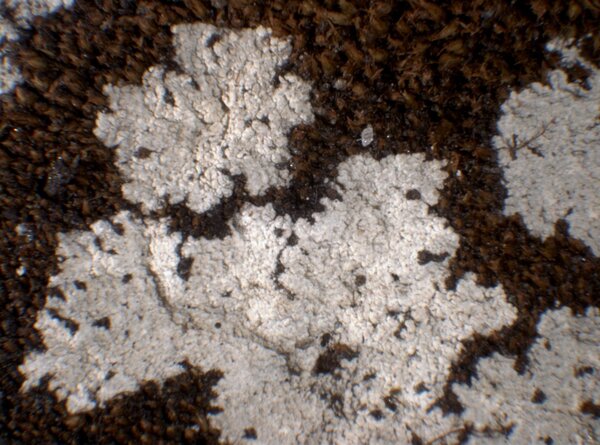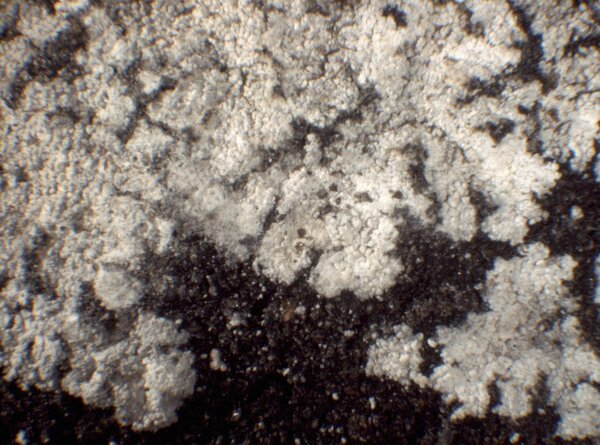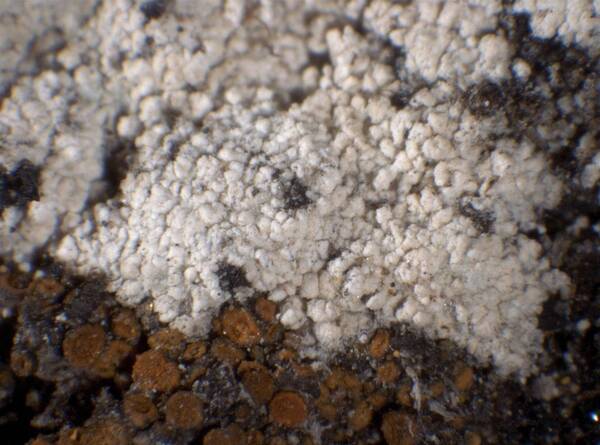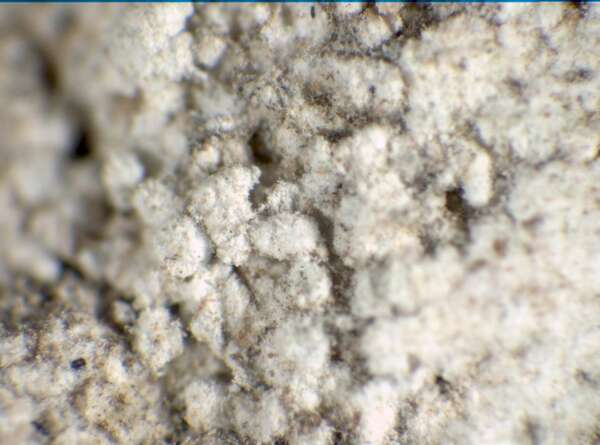Lepraria alpina (B. de Lesd.) Tretiach & Baruffo
in Baruffo & al., Nova Hedwigia, 83: 390, 2006. Basionym: Crocynia alpina B. de Lesd. - Bull. Soc. Bot. France, 61: 85, 1914.
Synonyms: Crocynia antarctica Hue; Crocynia caerulescens Hue; Crocynia candidissima Hue; Crocynia minima Hue; Lepraria angardiana Øvstedal; Lepraria cacuminum (A. Massal.) Loht.; Leproloma angardianum (Øvstedal) J.R. Laundon; Leproloma cacuminum (A. Massal.) J.R. Laundon
Distribution: N - Frl (Baruffo & al. 2006), Ven, TAA, Lomb, Piem (Baruffo & al. 2006), VA (Borlandelli & al. 1996, Piervittori & Isocrono 1999, Piervittori & al. 2004, Baruffo & al. 2006, Isocrono & al. 2008), Emil (Benesperi & al. 2007, Fariselli & al. 2020). C - Tosc (Baruffo & al. 2006, Benesperi & al. 2007). S - Cal (Puntillo 1996, Baruffo & al. 2006).
Description: Thallus crustose to subleprose, whitish to whitish grey, up to 0.7 mm thick, entirely consisting in a mass of granules, usually well-delimited, sometimes indistinctly sublobate at margin, forming up to 10 cm wide patches (usually less). The thallus starts developing as isolated, dispersed granules that form piles or aggregations (best visible along the margins, where the dispersion of the young granules is most readily observed), which eventually overlap and become confluent, giving the false appearance of a continuous thallus in older areas. Granules rather firmly attached, coarse, 80-150 μm in diam., sometimes gathered into 200-300 μm wide aggregates, with a well-developed pseudocortex, the surface appearing compact, rarely with very short projecting hyphae; Medulla white and cottony, rather thin (0.3-0.5 mm), often partially exposed. Photobiont chlorococcoid. Spot tests: K- or K+ yellow, C-, KC-, P- or P+ faintly yellow, UV-. Chemistry: atranorin, porphyrilic acid and a fatty acid (roccellic/angardianic or rarely rangiformic acid); very rarely fatty acids and/or atranorin can be absent.Note: on epilithic mosses and soil in alpine grasslands, in rain-subjected sites with a long snow-lie, both on siliceous and weakly calciferous substrata; rather common in the Alps, where it reaches the nival belt, rarer elsewhere in Italy.
Growth form: Leprose
Substrata: rocks, soil, terricolous mosses, and plant debris
Photobiont: green algae other than Trentepohlia
Reproductive strategy: mainly asexual, by soredia, or soredia-like structures (e.g. blastidia)
Commonnes-rarity: (info)
Alpine belt: common
Subalpine belt: rather common
Oromediterranean belt: rare
Montane belt: absent
Submediterranean belt: absent
Padanian area: absent
Humid submediterranean belt: absent
Humid mediterranean belt: absent
Dry mediterranean belt: absent

Predictive model
Herbarium samples

Miris Castello - CC BY-SA 4.0; Owner: Department of Life Sciences - University of Trieste
Antarctica, Terra Nova Bay.
Herbarium: TSB - Antarctic Herbarium

Miris Castello - CC BY-SA 4.0; Owner: Department of Life Sciences - University of Trieste
Antarctica, Terra Nova Bay.
Herbarium: TSB - Antarctic Herbarium

Miris Castello - CC BY-SA 4.0; Owner: Department of Life Sciences - University of Trieste
Antarctica, Terra Nova Bay.
Herbarium: TSB - Antarctic Herbarium
Growth form: Leprose
Substrata: rocks, soil, terricolous mosses, and plant debris
Photobiont: green algae other than Trentepohlia
Reproductive strategy: mainly asexual, by soredia, or soredia-like structures (e.g. blastidia)
Commonnes-rarity: (info)
Alpine belt: common
Subalpine belt: rather common
Oromediterranean belt: rare
Montane belt: absent
Submediterranean belt: absent
Padanian area: absent
Humid submediterranean belt: absent
Humid mediterranean belt: absent
Dry mediterranean belt: absent

Predictive model
| Herbarium samples |

Miris Castello - CC BY-SA 4.0; Owner: Department of Life Sciences - University of Trieste
Antarctica, Terra Nova Bay.
Herbarium: TSB - Antarctic Herbarium

Miris Castello - CC BY-SA 4.0; Owner: Department of Life Sciences - University of Trieste
Antarctica, Terra Nova Bay.
Herbarium: TSB - Antarctic Herbarium

 Index Fungorum
Index Fungorum
 GBIF
GBIF





